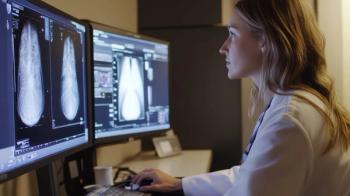
ROI in Reading Room Ergonomics
CHICAGO-Comprehensive research and experiments prove value of radiology reading room ergonomics.
There has never been a more critical time than today for improving radiology reading rooms, Eliot Siegel, MD, associate vice chair, diagnostic radiology and nuclear medicine, University of Maryland School of Medicine, said at RSNA 2015.
In the imaging chain, physicists will measure image acquisition, transmission, and display, but what isn’t measured in the process is radiologists.
“Our level of fatigue, visual acuity, where we are in relation to the workstation, and cognitive state, all critically important, we don’t even think of when we measure the imaging chain,” Siegel said.
Siegel stressed that the needs of the digital reading room are complexly different than what was required for an analog film department.
According to
Due to the lack of research in reading room ergonomics, Siegel’s radiology department at UMD created a laboratory to study radiology reading room design that has been in operation for about 23 years.
Location
One of the first challenges they tackled was the ideal location for a reading room. At UMD, the radiology department is located next to the MRI scanning room and the hospital lobby.
“We wanted to try to have the reading room be as centrally located as possible, near technologists and referring physicians,” Siegel said. “But the central location puts us in the middle of a lot of noise and activity, so we wanted to optimize the compromise between accessibility and the ability to be free of interruptions.”
A study in the
“Rethinking and taking advantage of the flexibility to be located in different areas is really an intriguing thing that we have now with instant access pretty much to all images,” he said.
Lighting
In the past, reading rooms had to be pitch black because the monitors had relatively poor output, Siegel said. This is no longer necessary with advanced monitor technology.
“Studies that we documented show an increase in radiologist fatigue when you have a mismatch between the monitor brightness and the room brightness,” Siegel said. “We actually documented a mismatch in brightness to result in a significant decrease in interpretation accuracy.”
The team found that LED lighting was optimal with warmer temperature bulbs (closer to about 3,000K). Siegel recommends an LED desk light and dimmable overhead LED lighting.
Visual Acuity[[{"type":"media","view_mode":"media_crop","fid":"47122","attributes":{"alt":"Eliot Siegel, MD","class":"media-image media-image-right","id":"media_crop_2385322829437","media_crop_h":"0","media_crop_image_style":"-1","media_crop_instance":"5522","media_crop_rotate":"0","media_crop_scale_h":"0","media_crop_scale_w":"0","media_crop_w":"0","media_crop_x":"0","media_crop_y":"0","style":"float: right;","title":"Eliot Siegel, MD","typeof":"foaf:Image"}}]]
Myopization, Siegel said, is a phenomenon that occurs when workers work in front of a computer monitor display for more than four hours a day, a radiologist’s typical day.
“These people have a lot of problems with fatigue and eye strain,” he said. “An increasing number of patients are going to their ophthalmologists or optometrists complaining of eye strain, tired eyes, eye fatigue, blurry vision, difficulty focusing, tearing, itching, and burning.”
Siegel explained that when your eyes are relaxed, they blink about 22 times per minute; when looking at a video display terminal or monitor, it’s closer to about seven blinks per minute.
“Two hours of work with a monitor is enough to actually reduce your measure of visual acuity,” he said. Visual acuity is especially important for radiologists and yet their measure of visual acuity decreases in as little as two hours of work. Even looking at the computer monitor requires 1.8 times more focusing effort than paper, Siegel said.
To reduce eye strain, Siegel suggested the 20/20/20 rule: every 20 minutes look 20 feet away for 20 seconds.
Blue background lighting suffused on the wall behind the workstation also has a favorable impact on visual acuity because humans are significantly more relaxed with indirect blue lighting, he said.
Ventilation
You wouldn’t drive a car that didn’t have ventilation or air flow, and yet many radiologists are reading in an environment with stale air that doesn’t move, Siegel said.
His team was inspired by the
The optimal ambient temperature is reported to be 78 degrees, but several factors including clothing influence a comfortable temperature. Siegel said that radiologists are actually more productive at colder temperatures, until a certain point when it gets too cold.
“If we are at the wrong temperature in our reading environment, it causes a greater amount of fatigue and potentially stress,” he said.
Acoustics
They didn’t used to consider noise, but Siegel said they pay a lot of attention to it now.
“There is a tremendous amount of background noise that is distracting, from the MRI next door to the lobby outside,” he said. “But to a greater extent, a lot of the noise is actually generated inside the room from people talking.”
One of the best things to do, according to Siegel, is invest $400-$500 in a sound masking system and sound absorbent materials. Rather than generate white noise, it sounds more like a ventilation system.
“We measured our MR bleed of noise as high as about 85 decibels or so, and with the sound masking and adding sound absorbent materials to the room, we don’t even notice the MR scanner next door,” he said. “All the discussion and talking inside the room gets absorbed by the sound absorbing carpet and ceiling.”
The radiologists were originally concerned about the sound masking system’s effect on voice recognition, but their research found that speech accuracy actually increased at low levels of sound.
ROI
Ergonomic upgrades are likely to be low priorities but Siegel vouched that they have an impressive return on investment.
His examples: Blue Cross Blue Shield noted a 4.4% improvement in productivity after implementing ergonomic design; Hopkins saw an 80% reduction in musculoskeletal disorders over a six year period after a comprehensive ergonomics program.
“People really notice that you care about them,” Siegel said. “[Ergonomic updates] can reduce turnover and absenteeism, improve morale, and increase employee involvement.”
Fails
Siegel also described a few experiments that didn’t work out so well:
• Strapping radiologists in: Nighthawk folks apparently swore by this. The radiologist would lay back like they would in a dental chair with the monitor and keyboard angled above them so they could essentially work while laying down. It didn’t work so well for those working during the day, considering it mimicked the optimal position for a nap.
• Walk station: They installed a treadmill walk station that went up to two miles per hour. This one quickly become a failure when radiologists refused to use it, or placed chairs on the treadmill belt and then complained that their chairs were falling off.
Newsletter
Stay at the forefront of radiology with the Diagnostic Imaging newsletter, delivering the latest news, clinical insights, and imaging advancements for today’s radiologists.





